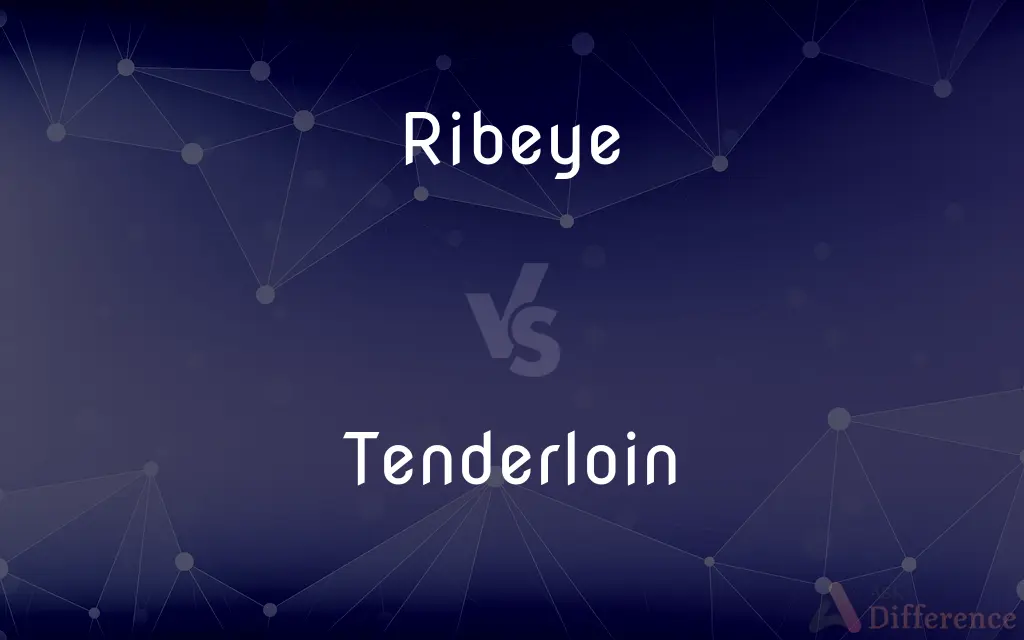Ribeye vs. Tenderloin — What's the Difference?
By Fiza Rafique & Maham Liaqat — Updated on March 29, 2024
Ribeye is a flavorful, marbled steak from the rib section, known for its rich taste and tender texture, while Tenderloin is the most tender cut, less marbled but extremely lean and smooth.

Difference Between Ribeye and Tenderloin
Table of Contents
ADVERTISEMENT
Key Differences
Ribeye steaks are celebrated for their marbling, which contributes to their rich flavor and juicy texture. This fat marbling is key to the steak's taste, as it melts during cooking, infusing the meat with flavor and maintaining moisture. On the other hand, the Tenderloin, also known as filet mignon when cut into steaks, is prized for its tenderness. It comes from a muscle that does little work, making it exceptionally lean and tender, though it lacks the marbling that gives Ribeye its distinctive flavor.
In terms of preparation, Ribeye steaks are versatile and can be cooked using various methods, including grilling, pan-searing, and broiling. The fat content in Ribeye allows it to remain tender and flavorful even when cooked to higher degrees of doneness. The Tenderloin, with its lower fat content, is best cooked using methods that can retain its moisture, such as searing and then finishing in the oven. It is often wrapped in bacon or served with sauces to enhance its flavor, given its lean nature.
Ribeye offers a robust beefy flavor that appeals to those who appreciate the taste of meat enhanced by fat. Its texture strikes a balance between tenderness and a slight chew, providing a satisfying eating experience. The Tenderloin, while not as flavorful on its own due to its minimal fat, offers a buttery texture that almost melts in the mouth, making it a favorite for those who prioritize tenderness over flavor intensity.
The choice between Ribeye and Tenderloin can also reflect dietary preferences. Those seeking a leaner option may prefer Tenderloin for its low fat content, while those looking for a more indulgent, flavorful steak might opt for Ribeye. This difference in fat content not only affects taste and texture but also the nutritional profile of each cut.
Culturally, both Ribeye and Tenderloin hold prestigious positions in the world of steaks, often featured in upscale restaurants and special occasions. However, their appeal varies by personal preference and tradition, with some cuisines and culinary practices favoring the rich flavor of Ribeye, while others prize the refined tenderness of Tenderloin.
ADVERTISEMENT
Comparison Chart
Part of Cow
Rib section
Loin, under the ribs
Marbling
High, contributes to flavor and juiciness
Low, very lean
Flavor
Rich and beefy
Milder, less beefy
Texture
Tender with a slight chew
Extremely tender, almost buttery
Cooking Methods
Grilling, pan-searing, broiling
Best seared and then oven-finished
Dietary Consideration
Higher in fat, more calories
Leaner, fewer calories
Cultural Preference
Favored for its flavor and juiciness
Prized for its tenderness and refinement
Compare with Definitions
Ribeye
A steak cut from the rib section of the cow, known for its fat marbling.
The Ribeye steak, with its generous marbling, promises a juicy and flavorful experience.
Tenderloin
The most tender cut of beef, located along the spine.
Tenderloin, or filet mignon, is renowned for its soft, buttery texture.
Ribeye
Versatile in cooking methods.
Pan-searing a Ribeye and finishing it with butter enhances its natural flavors.
Tenderloin
Mild and subtle, often enhanced with sauces.
A bacon-wrapped Tenderloin introduces additional flavors to the lean cut.
Ribeye
Rich and robust, enhanced by fat marbling.
Grilling a Ribeye brings out its deep, beefy flavors.
Tenderloin
Lean and low in fat, making it a healthier option.
Choosing Tenderloin allows for a luxurious meal without the extra fat.
Ribeye
Tender but with a satisfying chew.
The Ribeye offers a perfect balance of tenderness and texture.
Tenderloin
Requires careful cooking to retain moisture.
Tenderloin steaks are best when quickly seared and then gently roasted.
Ribeye
Higher fat content provides a richer taste.
The Ribeye's marbling contributes to its higher calorie content but ensures a flavorful meal.
Tenderloin
Extremely tender, with a smooth, almost melt-in-the-mouth feel.
The Tenderloin is so tender that it requires minimal chewing.
Ribeye
Ellipsis of ribeye steak}}; {{qualifier
Tenderloin
The tenderest part of a loin of beef, pork, or similar cut of meat.
Ribeye
Synonym of ribsteak}} {{gloss
Tenderloin
A city district notorious for vice and graft.
Ribeye
A run batted in.
Watson had a 3-run homer and a 2-run double for a total of five ribeyes on the night.
Tenderloin
The tenderest part of a loin of meat, especially of pork or beef.
Tenderloin
A district of a city where corruption is common, often because the district is devoted to questionable businesses (peep shows, etc) which are easy for police to blackmail and extort.
Tenderloin
A strip of tender flesh on either side of the vertebral column under the short ribs, in the hind quarter of beef and pork. It consists of the psoas muscles.
Tenderloin
In New York City, the region which is the center of the night life of fashionable amusement, including the majority of the theaters, etc., centering on Broadway. The term orig. designates the old twenty-ninth police precinct, in this region, which afforded the police great opportunities for profit through conniving at vice and lawbreaking, one captain being reported to have said on being transferred there that whereas he had been eating chuck steak he would now eat tenderlion. Hence, in some other cities, a district largely devoted to night amusement, or, sometimes, to vice.
Tenderloin
A city district known for its vice and high crime rate
Tenderloin
The tender meat of the loin muscle on each side of the vertebral column
Common Curiosities
What is the main difference in flavor between Ribeye and Tenderloin?
Ribeye is known for its rich, beefy flavor due to fat marbling, while Tenderloin has a milder taste and is often served with sauces to enhance its flavor.
Can Tenderloin be cooked to the same degree of doneness as Ribeye?
Yes, but Tenderloin is best enjoyed at lower degrees of doneness to maintain its moisture, given its lower fat content.
How does the cost of Ribeye compare to Tenderloin?
Both cuts are on the higher end price-wise, but Tenderloin is often more expensive due to its tenderness and lower fat content.
Why might someone choose Tenderloin over Ribeye?
Someone might prefer Tenderloin for its exceptional tenderness and lower fat content, especially if they are looking for a leaner steak option.
How should Ribeye be cooked to maximize its flavor?
Ribeye is best cooked by grilling or pan-searing to develop a flavorful crust while retaining its juiciness.
What sauces are commonly served with Tenderloin?
Tenderloin is often accompanied by rich sauces like béarnaise or red wine reductions to complement its mild flavor.
Which is more tender, Ribeye or Tenderloin?
Tenderloin is the more tender of the two, with a texture that is almost buttery.
Can the fat in Ribeye be considered healthy?
In moderation, the fats in Ribeye can be part of a balanced diet, but Tenderloin is a leaner choice for those concerned with fat intake.
Can both Ribeye and Tenderloin be grilled?
Yes, but Ribeye is more forgiving on the grill due to its fat content, while Tenderloin requires more careful cooking to avoid drying out.
Is Ribeye or Tenderloin better for a special occasion?
Both are excellent choices; the decision often depends on personal preference for flavor (Ribeye) or tenderness (Tenderloin).
Is there a nutritional advantage to choosing Tenderloin over Ribeye?
Yes, Tenderloin is leaner, making it a better choice for those seeking a lower-fat option.
What makes Ribeye so flavorful?
The marbling of fat within Ribeye melts during cooking, infusing the steak with moisture and rich, beefy flavors.
How do the textures of Ribeye and Tenderloin compare?
Ribeye offers a tender yet slightly chewy texture, while Tenderloin is softer and smoother, requiring minimal chewing.
Which steak is better for health-conscious individuals?
Health-conscious diners might prefer Tenderloin for its lower fat content and calories, making it the leaner option.
Why is Tenderloin often wrapped in bacon?
Bacon adds fat and flavor to the lean Tenderloin, enhancing its taste and preventing it from drying out during cooking.
Share Your Discovery

Previous Comparison
Perpendicular vs. Normal
Next Comparison
Footing vs. PedestalAuthor Spotlight
Written by
Fiza RafiqueFiza Rafique is a skilled content writer at AskDifference.com, where she meticulously refines and enhances written pieces. Drawing from her vast editorial expertise, Fiza ensures clarity, accuracy, and precision in every article. Passionate about language, she continually seeks to elevate the quality of content for readers worldwide.
Co-written by
Maham Liaqat













































